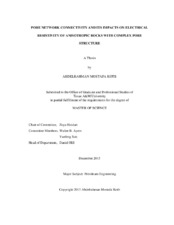| dc.description.abstract | Core data and well-log interpretation results are usually comparable in homogenous conventional reservoirs. However, in the case of thinly-bedded, heterogeneous formations consisting of organic-rich mudrocks and carbonates, core-log calibration and integration are challenging. The calibration of well-log interpretation results with core data is hence justified for thick homogeneous beds. Consequently, petrophysical properties (e.g., fluid saturation) estimated from well logs are not generally in agreement with core measurements. Therefore, upscaling of petrophysical properties from core-scale to log-scale is essential to reconcile measurements obtained from different scales. Although petrophysical measurements vary from core-scale to log-scale, previous publications have shown that the relationship between formation factor and porosity is consistent over a wide-scale range in homogenous sandstones. These correlations, however, do not persist in rocks with complex pore structure and rock fabric (e.g., carbonates).
This research investigated the persistence of a correlation between the electrical resistivity and the directional connectivity tensor at different scales within the micron scale in sandstone and carbonate examples. To fulfill this objective, three-dimensional (3D), pore-scale rock images were obtained from micro-CT (Computed Tomography) images. Then, each 3D pore-scale image was divided into subsamples of varying sizes. Afterwards, tortuosity of the networks of the electrically conductive rock components (e.g., formation water) was estimated in each subsample. The next step was to numerically solve the Laplace’s equation to estimate electric field distribution and effective electrical resistivity of each subsample. The last step involved calculating the directional connectivity tensor based on the estimated tortuosity and volumetric concentration of each conductive component in the samples and subsamples. Finally, the impact of directional connectivity of pore network on electrical resistivity was quantified.
The results confirmed the existence of a correlation between directional connectivity and electrical resistivity at different micron scales in the samples studied in this thesis. Improvements of up to 59% and 54% were observed in the proposed relationship compared to the conventional relationship between porosity and electrical resistivity in fully and partially water-saturated samples, respectively. An improvement of up to 50% in estimates of water saturation was observed when the directional connectivity of pore network was taken into account. | en |


